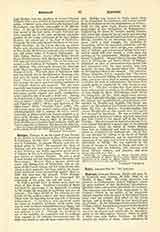

Hidalgo, MIGUEL, b. on the ranch of San Vicente in the district of Guanajuato, May 8, 1753; executed at Chihuahua, July 30, 1811. Hidalgo studied in the city of Valladolid, the present Morelia, and was ordained priest in 1778. He occupied the chair of theology and was later named rector of the College of San Nicholas, and finally appointed parish priest of Dolores in the state of Guanajuato. The town is now known as Dolores Hidalgo. He was a good French scholar and had read Rousseau, Beccaria, and Montesquieu. Manuel Abad y Queipo, afterwards canon and Bishop-elect of Michoacan, also an admirer of the French writers, was his warm friend, and, owing to their partiality for these writers, the Inquisition instituted secret proceedings against them in 1800, but they were not pressed. While Hidalgo was parish priest of Dolores he encouraged the cultivation of the grape vine and silk worm.
In 1810 a general wave of unrest swept over the whole of New Spain. Napoleon’s invasion of Spain had fired the patriotism of the Spaniards, revealing to the creoles the meaning of patriotism and love of country. The taxes levied on the colonies for the benefit of the mother country also bred discontent. These were the impelling forces that led to Mexican independence. A committee was organized under the name of Academia Literaria, whose secret plan was to work to obtain independence from Spain, and after some hesitation on his part the Cura Hidalgo was induced to join it. Through the treachery of one of the members the committee and its workings were exposed to the colonial Government and the order was issued to seize all those connected with the plot. Hidalgo was warned by Dona Josefa Ortiz of the betrayal of the committee, and without further delay he declared openly for independence on September 16, 1810, the day upon which Mexico celebrates the anniversary of the Declaration of Independence. Augmenting his forces by recruits, mostly Indians, who joined him along the line of march, and selecting the banner of the Virgin of Guadalupe for his standard, Hidalgo marched to the important city of Guanajuato. After a brief struggle, the Alhondiga de Granaditas, where the municipal authorities and the Spanish citizens had taken refuge, was captured. Acts of violence and unwarranted pillage were committed which will ever remain a stain upon the memory of the perpetrators. Hidalgo then turned toward Valladolid. Manuel Abad y Queipo, Bishop-elect of Michoacan and former friend of Hidalgo, published an edict of excommunication against him and threatened with the same penalty, ipso facto incurred, all those who should follow him. Several of the bishops followed his example. The historian, Miguel Miguelez, O.S.A., remarks that “the intention was to discredit Hidalgo by whatever means possible, and if the latter erred in making use of religion to further the work of independence, the former were equally guilty in employing the same means to suppress it”. The fact remains that these edicts were most unfavorably received, as the official deposition of Fray Simon de Mora, Mercedarian, made before the Inquisition, December 20, 1810, amply bears witness.
From Valladolid Hidalgo turned his army towards the capital, and vanquished the colonial forces, commanded by Trujillo and Iturbide (the future emperor), on the mount of Las Cruces, a short distance from the City of Mexico. Notwithstanding this victory Hidalgo did not dare march on to the capital but returned to Queretaro. He was overtaken and vanquished at Aculco by Calleja, who had come from San Luis Potosi at the urgent call of the Viceroy Venegas. The movement he had initiated had, however, spread throughout a greater part of the colonial possessions. After the defeat of Aculco Hidalgo went first to Valladolid and then to Guadalajara, where he established his headquarters. On January 14 he was defeated by Calleja in the battle of Puente Grande near Guadalajara, and he surrendered the command of the army and retired to Zacatecas, and afterwards to Saltillo. He was captured on the charge of treason at Acatita de Bajan and taken to Chihuahua with his followers, the principal ones being Allende, Aldama, and Jimenez, and after being degraded was shot.
CAMILLUS CRIYELLI

